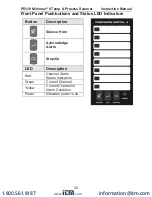
PD138 Minimux
®
II Temp & Process Scanner
Instruction Manual
26
Alarms
Each channel of the Minimux
®
II has an independent ‘Alarm-In’ terminal
that allows an external device to trigger an alarm on the Minimux
®
II. The
external device may be the relay contacts on a digital panel meter, such
as the PD765-6R2-00, or the digital output from a PLC. When an
external device detects an alarm condition, it drives the appropriate
Alarm-In line on the Minimux
®
II low. When the PD138 reaches this
channel, its LED will turn red and flash, the built-in horn will sound and
the alarm relay will transfer.
Alarms are acknowledged by pressing the ACK button or closing a
pushbutton wired across terminals at the rear of the instrument. When an
alarm is acknowledged, the horn will silence and the relay will change
state. The alarmed LED (red) will not return to normal until the alarm
condition has been corrected and that channel is scanned again.
The PD138 can be field programmed to react to alarm conditions in one
of two ways: Sequence A or Sequence F2A (first-out). Sequence A
detects both momentary and maintained alarms. Sequence F2A also
detects both momentary and maintained alarms as well as which alarms
occurred first on a complete scan cycle.
First-Out Alarms (F2A)
The main feature of Sequence F2A is its ability to indicate which alarms
occurred first. In a system where all inputs are monitored simultaneously,
this is a fairly straightforward concept. However, in a scanned system
such as one using a PD138, where the inputs are monitored one at a
time, it is not really possible to tell which alarm really occurred first. All
that is known is which alarm was detected first.
For this reason, the
PD138 recognizes first-out alarms as all alarms that occur during
the first complete scan. This is from the time the unit detects the
first alarm until the scanning goes around and passes through that
first alarmed point once again. First-out alarms are indicated by
flashing red LEDs. Secondary alarms are indicated by steady red
LEDs.
The PD138 detects an alarm only if the alarm is present (alarm-in line is
low) while the channel is being scanned. For dwell times greater than 2
seconds, the ‘alarm-in’ line is poled after the PD138 has been on that
channel for 2 seconds. If the dwell time is less than 2 seconds, the
‘alarm-in’ line is poled 0.05 seconds before the PD138 moves on to the
next channel.
www.
.com
1.800.561.8187











































